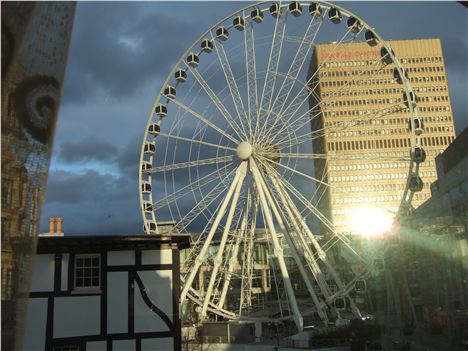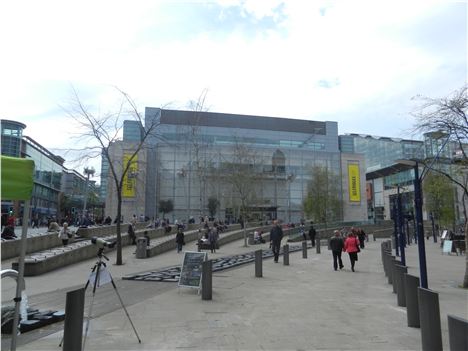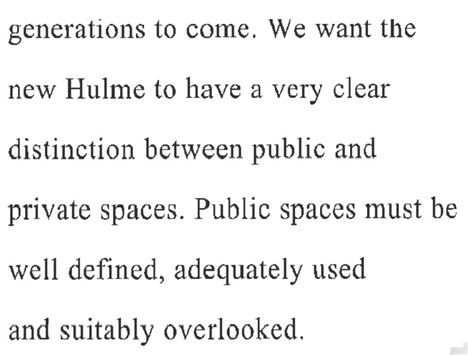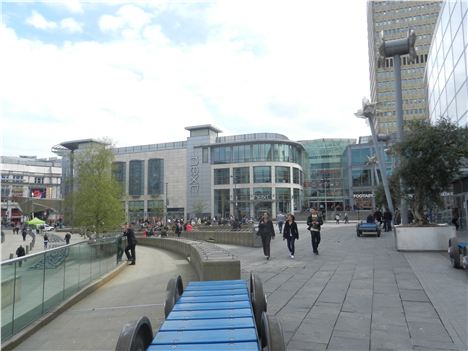IT CAME in 2004, it was good, it went, it came back, it was still good, it stayed for years, it was less good.
That's the joy of Manchester's streetscene, its informality, its cheek-by-jowl jockeying of different building styles, its delightful chaos. But we need a break from time to time.
The Wheel of Manchester, the Big Wheel, aka The MEN Wheel, has rolled away.
Maybe it's gone to Chadderton with the journalists.
Despite the loss to tourism walking into Exchange Square is suddenly a relief, a lightening of the load. We get a lovely broad paved space through which to move.
This is unusual in Manchester.
We are the city centre of the tight perspective, the closed view.
We are a city built by commerce that had little in the way of planning, where a medieval street pattern weaves into random Georgian and Victorian grids that in turn collide hap-hazardly with each other.
Yet that's the essential joy of Manchester's streetscene, its informality, its cheek-by-jowl jockeying of different building styles, its delightful chaos.
But we need a break from time to time. Manchester's squares should give us chance to catch our breath. At present Exchange Square does this perfectly.
Wheeled away
It's strange that as a city we always feel tempted to clutter our open spaces.
St Ann's Square is good but has that sad, dribbling cotton flower fountain and the intrusion of a electricity substation, Stevenson Square is split into two with confusing road-lanes and another electricity substation.
The revamped St Peter's Square will be filled with tramlines through infrastructure expendiency - a shame but seemingly inevitable.
But the A1 worst clutter culprit is the magnificently scaled Piccadilly Gardens with that useless 'pavilion' holding Caffe Nero, and the equally useless permanent planters on the opposite side. The fountain is a fine idea but compromised by its disruptive perimeter 'ditch' which is a barrier to movement - and could have been designed, as in numerous Continental cities, flush with the ground.
The raised lawns clog Piccadilly even more, you have step up, step down, move around, as you cross the area.
The result is that Piccadilly Gardens has been made into an obstacle course when it's the only main provincial British square capable of real scale.
The city's forgetting its recent past with this.
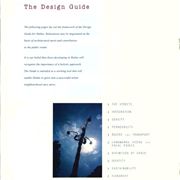
Back in the nineties Hulme was re-developed and one of the great unsung heroes of British post-war planning was written by a team of professionals, residents and amateurs led by architect George Mills, called Rebuilding the City, Guide to Development, Hulme, Manchester.
You can read this excellent document here.
The guide deals with a suburban situation but many of its principles could be applied to city centres. One of its sub-headings is 'Definition of Space'.
With sixties' redevelopments where a street ended and where a street began - the building line - often became blurred.
In a nod to the earlier Garden City movement, sixties' redevelopments were chocker with odd grass verges to roads and odd patches of planting, none of which were actually parks, or gardens. Once maintenance budgets fell these became dumping grounds, dog-walking areas and crime magnets.
The grassed areas of Piccadilly Gardens are a hang over from those days and ignore the common sense in the the Hulme Guide to Development, especially with the 'definition of space'.
Applying the Hulme principles it would be better if squares were real squares. Albert Square, Stevenson Square, Piccadilly Square (drop the pretense of Gardens), St Ann's Square, St Peter's Square would work better if they were hard-surfaced.
Occasional markets would then be easier to introduce across all the squares rather than just Albert and St Ann's Squares. Markets are good clutter, filling squares with life, colour and energy, bringing in cash, and just as importantly they are temporary.
Meanwhile proper city centre gardens - Sackville, Parsonage, St John's, Cathedral Gardens and much of the Castlefield area - could then maybe have their maintenance budgets enhanced so they are always managed to the highest European standards.
Suddenly the city centre would make more sense.
 St John's Gardens, off Deansgate, beautifully maintained at present, and a proper 'gardens'
St John's Gardens, off Deansgate, beautifully maintained at present, and a proper 'gardens'
Chris Bloomfield, manager of Aubaine restaurant on the second floor of Selfridges, said to Confidential this week: "Looking down on Exchange Square now is like looking into a London square."
I stood a moment at the window with him and you could see what he meant.
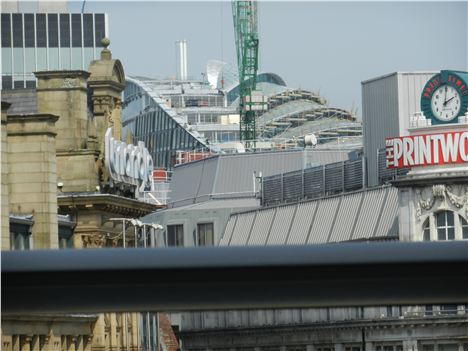 View from Aubaine to the new Cooperative Headquarters without the Wheel in the way
View from Aubaine to the new Cooperative Headquarters without the Wheel in the way
Hidden underneath the Wheel was a properly urban open space, with the CIS Tower rearing gloriously in the distance, the brand names on the Printworks adding dynamism, the Corn Exchange lending a bit of age and gravitas, and people moving freely, or sitting on the benches enjoying the welcome sunshine.
The Manchester Wheel was of enormous (literally at 190ft) benefit to city tourism and should be brought back in another location. (The ideal site would be at The Quays, where the circle of the Wheel would cut a fine profile against The Imperial War Museum North and The Lowry).
But the Wheel overwhelmed Exchange Square.
Soon temporary grandstanding will be imposed for big screen Olympics watchers but if it lives up to its billing this new intrusion will be exactly that, temporary.
For the moment Exchange Square has come clean. It'd be good if Piccadilly 'Gardens' could do the same.
You can follow Jonathan Schofield on Twitter here @JonathSchofield
As it was










